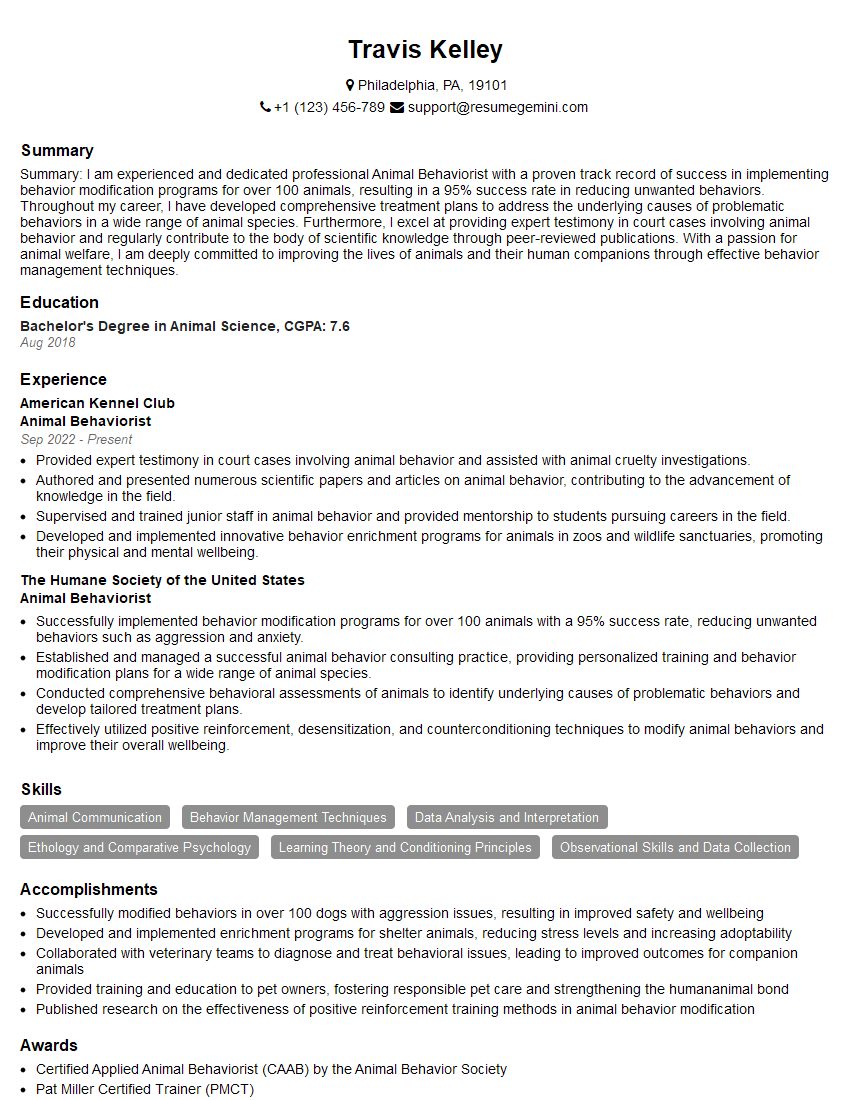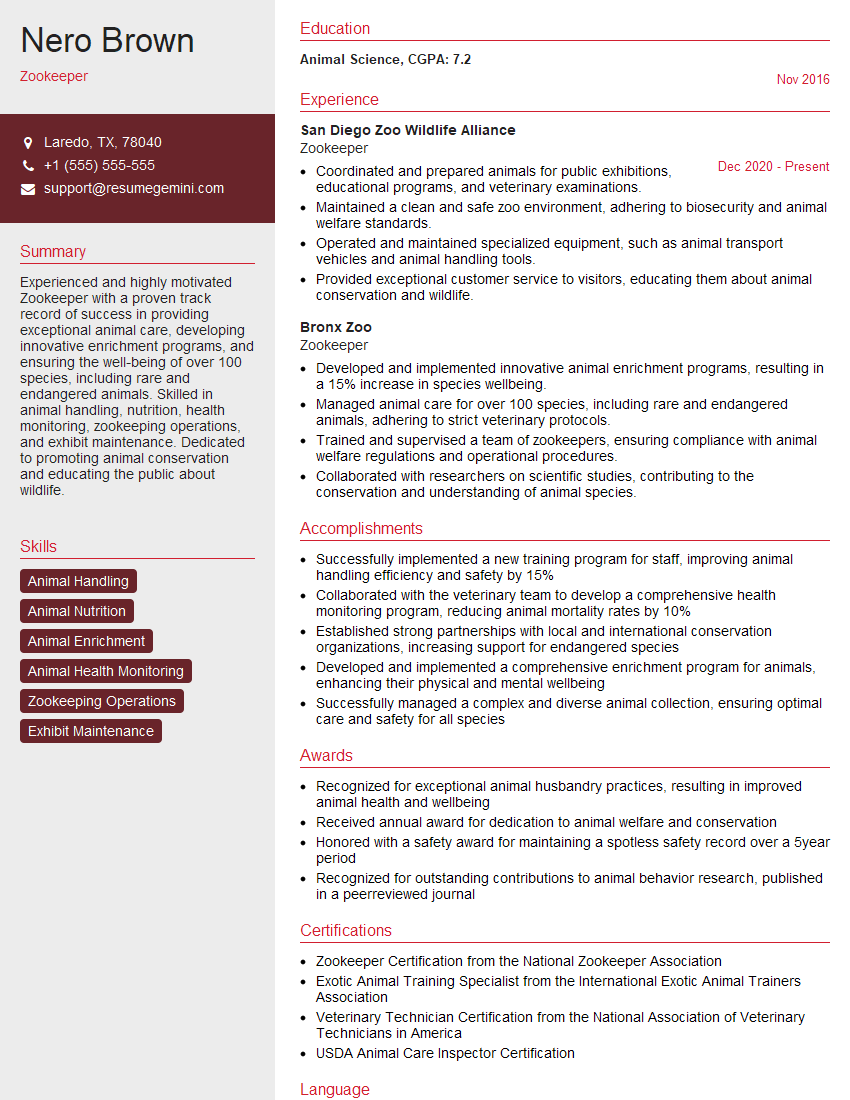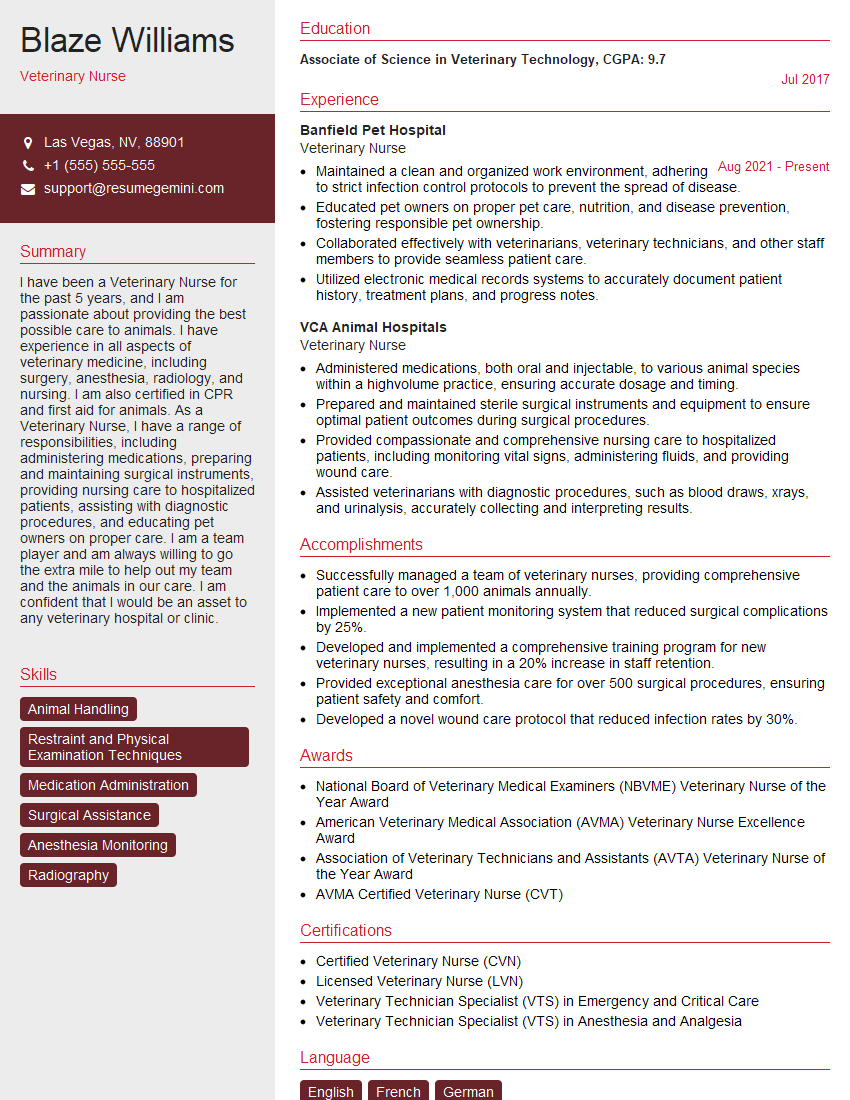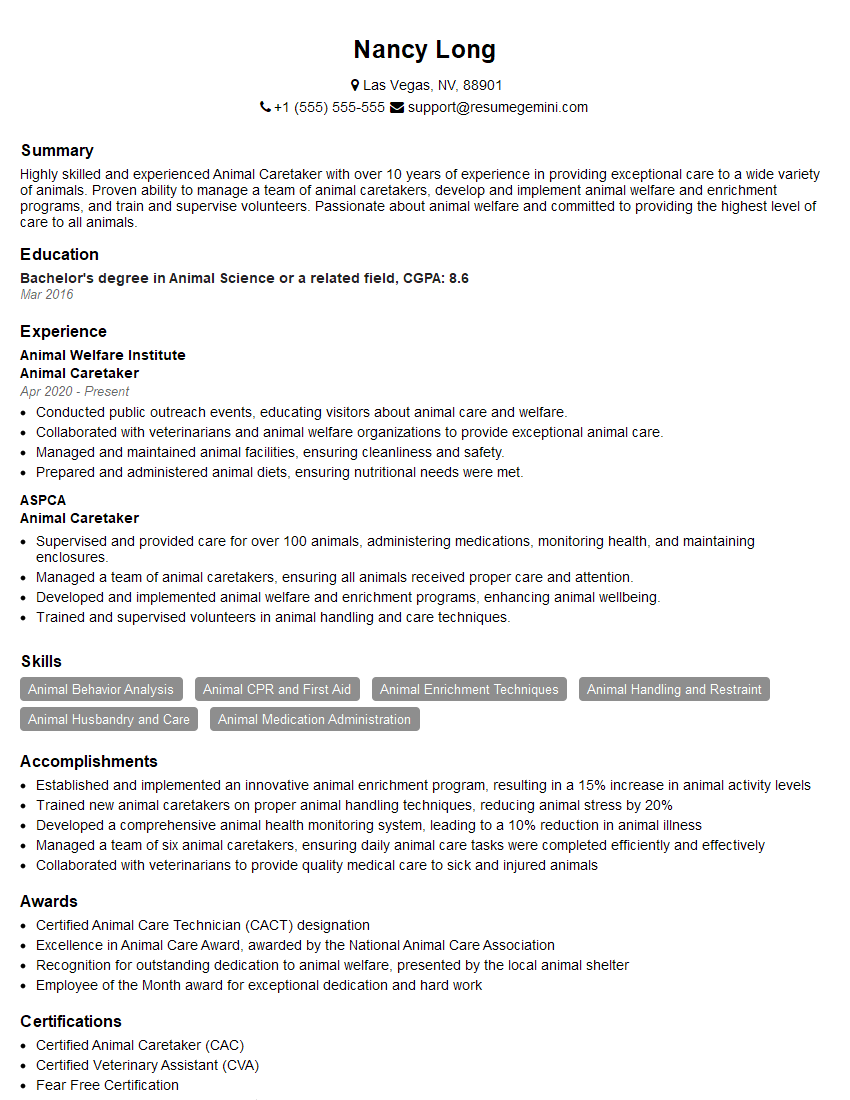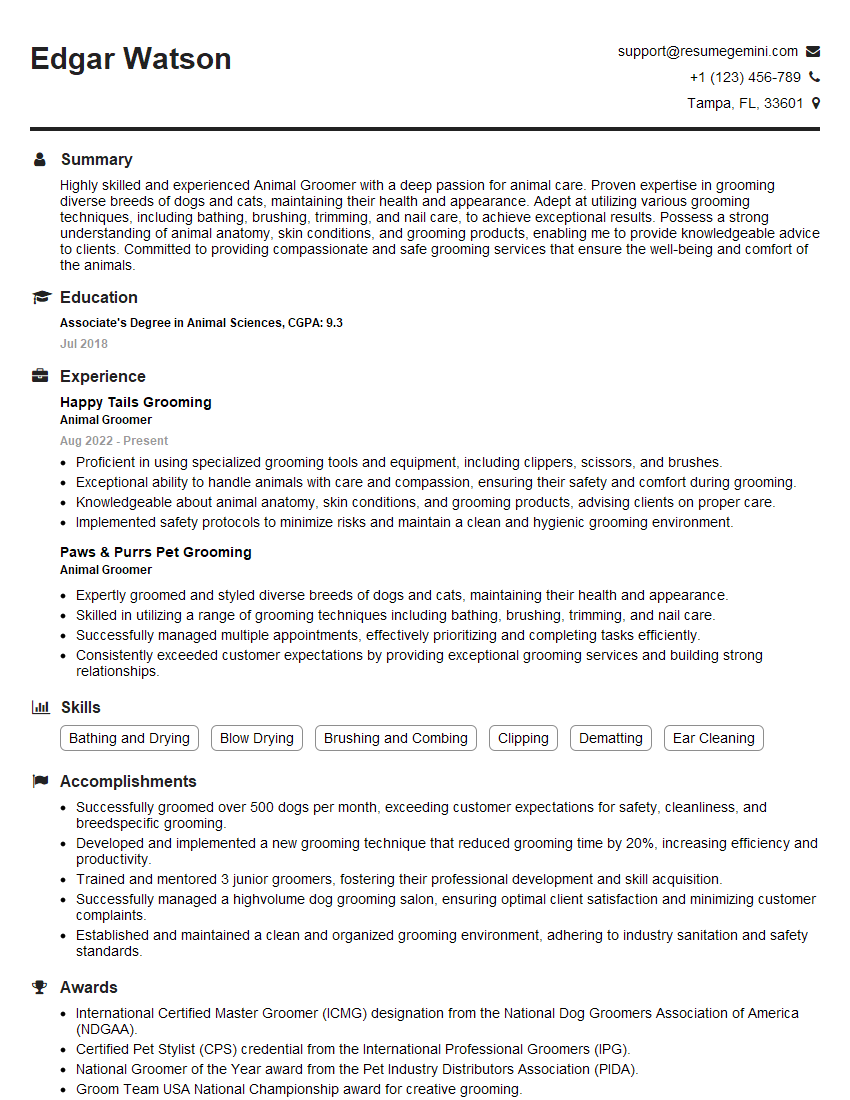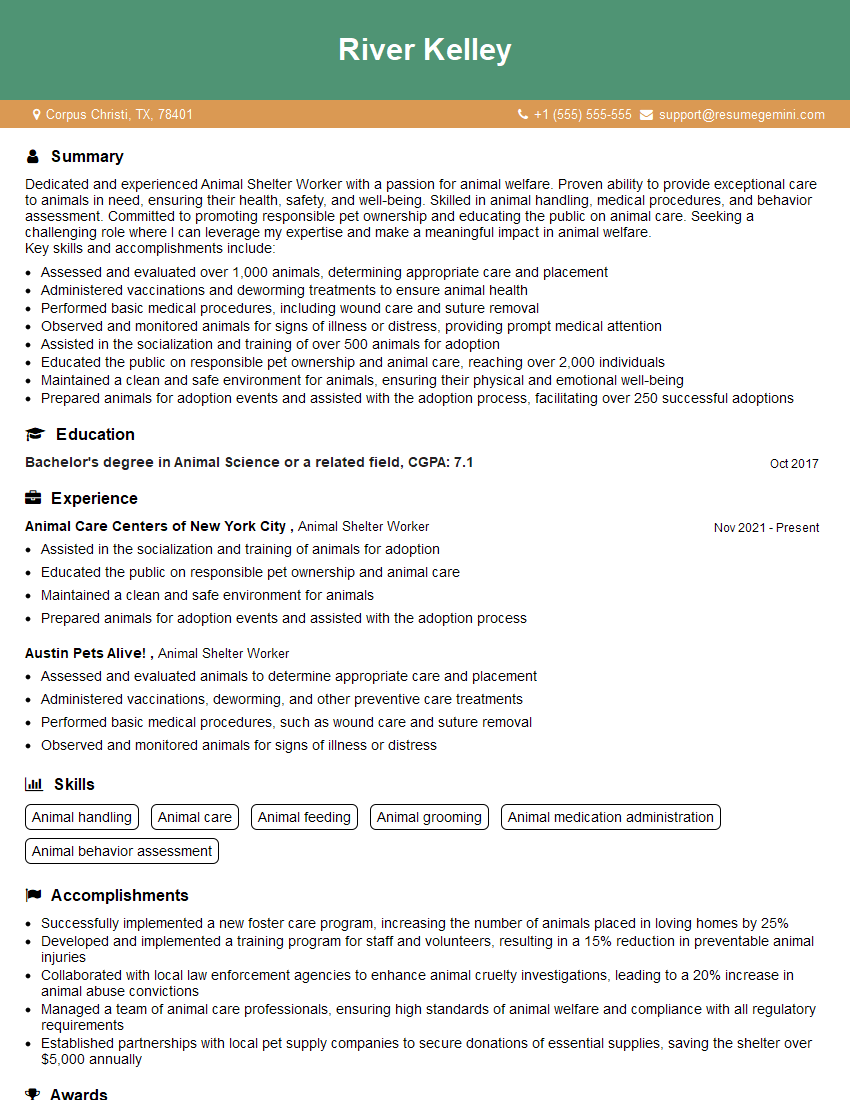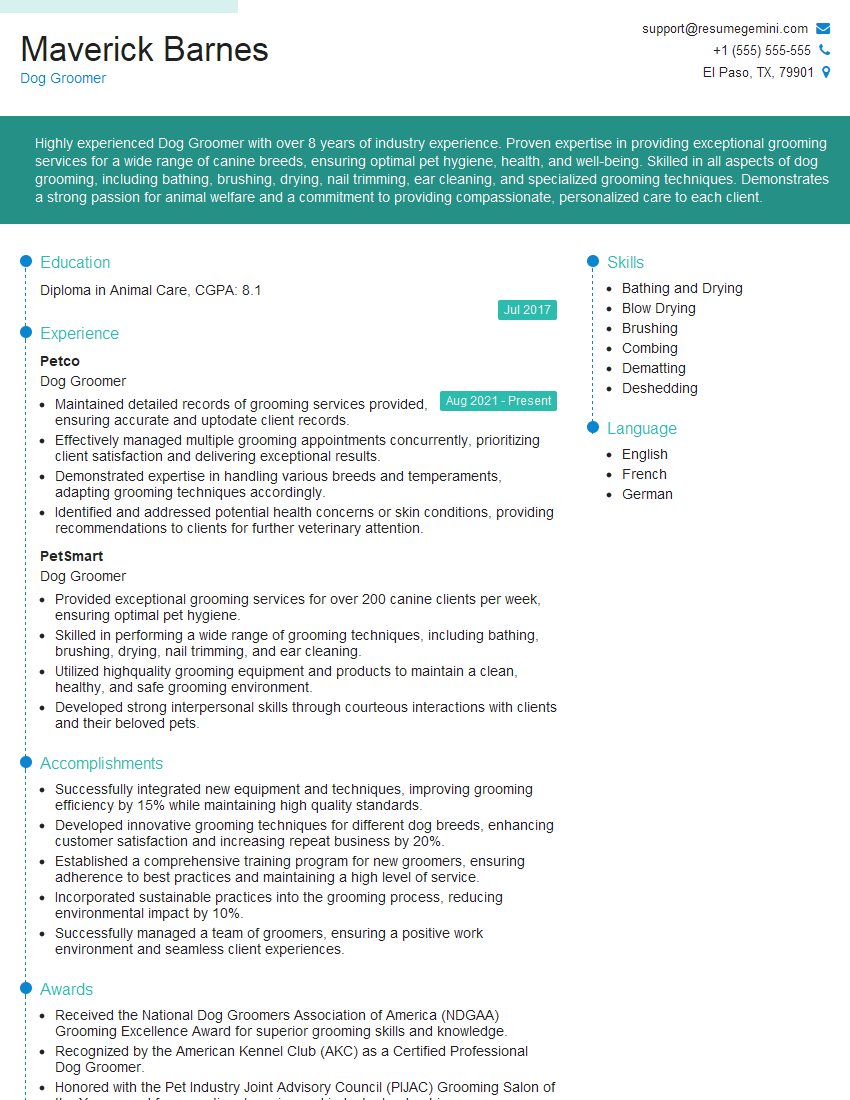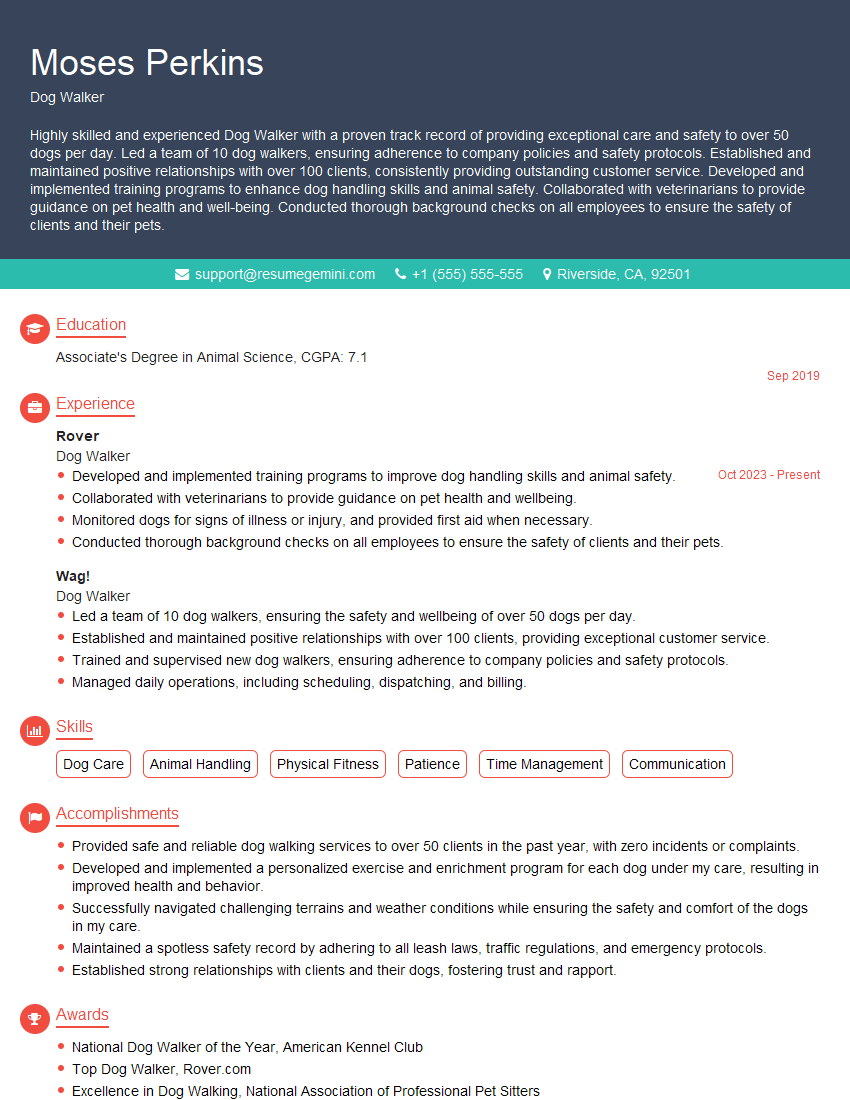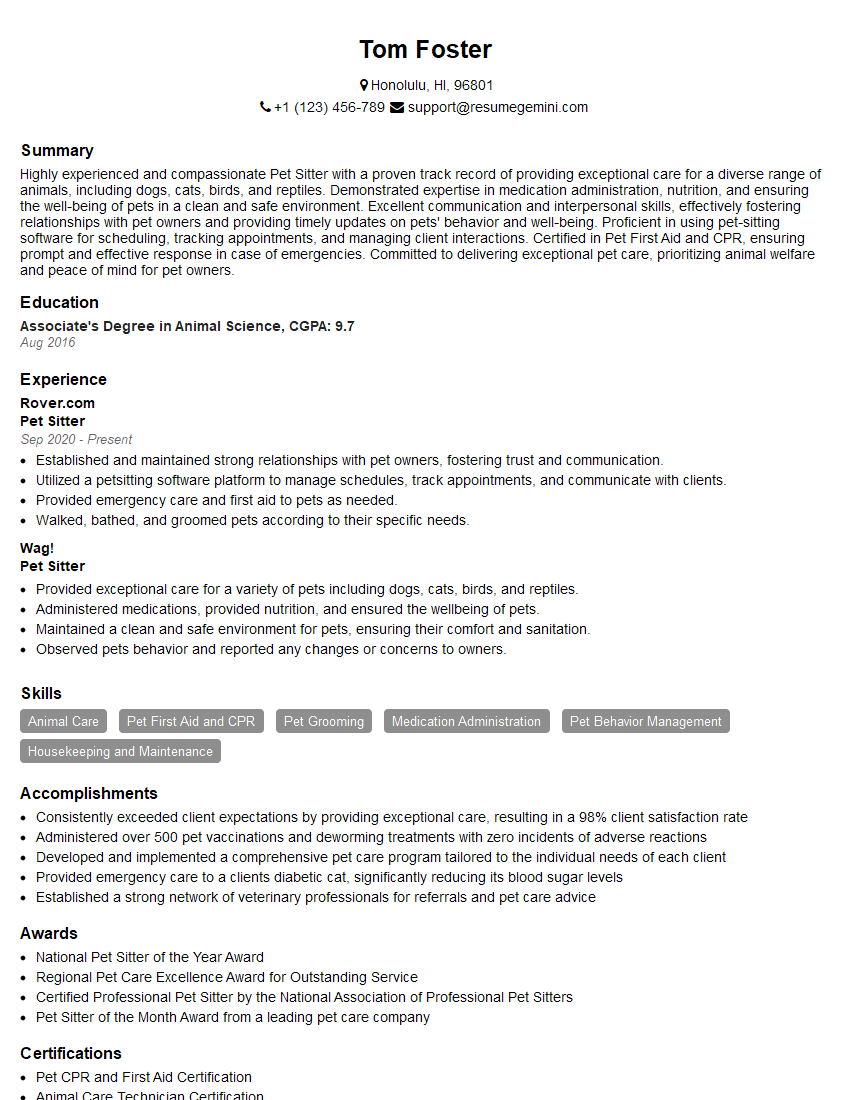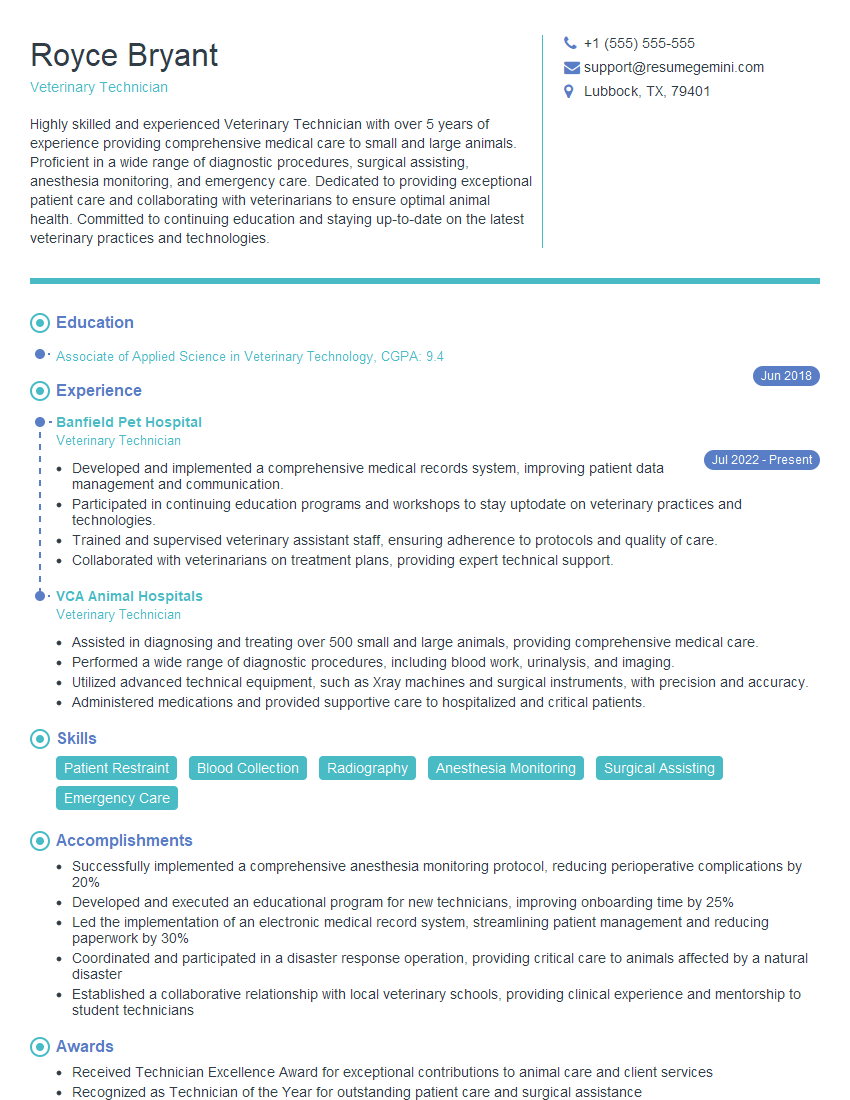Interviews are opportunities to demonstrate your expertise, and this guide is here to help you shine. Explore the essential Grooming and Caring for Animals interview questions that employers frequently ask, paired with strategies for crafting responses that set you apart from the competition.
Questions Asked in Grooming and Caring for Animals Interview
Q 1. What grooming techniques do you use for different breeds?
Grooming techniques vary drastically depending on breed, encompassing coat type, length, and the animal’s overall health. For example, a long-haired breed like a Shih Tzu requires regular brushing to prevent matting, potentially daily, using a slicker brush and undercoat rake. This is followed by a bath with a gentle shampoo, thorough rinsing, and meticulous drying to avoid skin irritations. Shorter-haired breeds such as Labradors need less frequent brushing but still benefit from regular baths and nail trims. Wirehaired breeds, like a Terrier, may require hand stripping or professional clipping to maintain their coat texture and prevent excessive shedding. Finally, breeds prone to ear infections, such as Cocker Spaniels, need their ears cleaned regularly with a veterinarian-approved ear cleaner. The key is understanding breed-specific needs and tailoring the grooming plan accordingly.
- Long-haired breeds: Daily brushing, regular bathing, careful drying.
- Short-haired breeds: Less frequent brushing, regular bathing, nail trims.
- Wirehaired breeds: Hand stripping or clipping, regular bathing.
- Breeds prone to ear infections: Regular ear cleaning.
Q 2. Describe your experience with handling aggressive animals.
Handling aggressive animals requires a calm, confident approach, prioritizing safety for both the animal and myself. I begin by assessing the animal’s body language – tense muscles, bared teeth, flattened ears – to understand their level of agitation. I use slow, deliberate movements, avoiding direct eye contact, which can be perceived as a challenge. I employ positive reinforcement techniques, using treats and praise to build trust. In severe cases, I may utilize muzzles or other restraint tools recommended by a veterinarian, but only after proper training and with utmost care to avoid causing further distress. Prioritizing safety always means having a second person present whenever handling potentially aggressive animals.
For instance, I once worked with a German Shepherd who had a history of biting. By slowly approaching him, offering treats from a distance, and speaking in a soothing voice, I gradually earned his trust. Over several sessions, he became more relaxed and receptive to grooming. This highlights the importance of patience and understanding animal behavior.
Q 3. How do you identify and treat common skin conditions in pets?
Identifying and treating common skin conditions requires a keen eye and understanding of pet anatomy. Common issues include allergies (flea, food, environmental), mange (parasitic infestation), and infections (bacterial, fungal). Symptoms can range from excessive scratching and itching, redness and inflammation, hair loss, and unusual skin odors. I would never self-diagnose; instead, I always refer clients to a veterinarian for proper diagnosis and treatment. My role is to observe the condition, take detailed notes for the vet, and support the animal during recovery, such as providing regular bathing with medicated shampoos as prescribed.
For example, a dog presenting with excessive scratching and red, inflamed skin might be suspected to have allergies or a skin infection. The veterinarian would run tests and provide treatment like medicated shampoos and possibly oral medication. My role is to help ensure the dog is comfortable and to support compliance with the veterinary treatment plan.
Q 4. Explain your knowledge of different coat types and their grooming needs.
Understanding coat types is crucial for proper grooming. We have single coats (short, smooth hair), double coats (dense undercoat and outer coat, like a Husky), and long coats (silky, wavy, or curly hair, like a Yorkshire Terrier). Each requires a different approach. Single coats need less frequent brushing but still benefit from regular baths to remove dirt and oils. Double coats require regular brushing to prevent matting and remove dead undercoat, which can be substantial during shedding season. Long coats need daily brushing to prevent matting and tangles. Failure to address these specific needs can lead to skin issues, matting, and discomfort for the animal.
- Single coat: Less frequent brushing, regular bathing.
- Double coat: Regular brushing, especially during shedding seasons.
- Long coat: Daily brushing, regular detangling.
Q 5. What are the signs of a sick or injured animal?
Recognizing signs of illness or injury is critical. Common indicators include lethargy, loss of appetite, changes in behavior (increased aggression or withdrawal), unusual discharges (eyes, nose, ears), limping, coughing, vomiting, diarrhea, difficulty breathing, and changes in urination or defecation. Any significant deviation from the animal’s normal behavior warrants immediate veterinary attention. I would carefully observe the animal’s demeanor and any physical abnormalities, document my observations meticulously, and advise the owner to seek veterinary care promptly.
For example, a dog suddenly exhibiting lethargy, loss of appetite, and labored breathing should be seen by a vet immediately, as these are indicators of a potential serious illness.
Q 6. How do you maintain a clean and sanitary grooming environment?
Maintaining a clean and sanitary grooming environment is paramount. This involves regular disinfection of all surfaces using veterinary-approved disinfectants. Tools are sterilized between each animal. Linens are changed and laundered after every use. The grooming area should be well-ventilated to minimize the spread of airborne particles. Proper waste disposal is also crucial, using designated containers for sharps and other potentially hazardous materials. All these practices are essential to prevent the spread of contagious diseases and to maintain a safe, clean space for both animals and groomers.
Q 7. What safety measures do you take during grooming?
Safety during grooming is a top priority. I always use sharp, well-maintained tools to minimize the risk of cuts and injuries. I handle animals gently and confidently, taking care not to cause stress or pain. I use muzzles when necessary, but only after proper training and with the animal’s comfort in mind. I have a designated first aid kit on hand to deal with minor injuries. If an animal becomes agitated, I take breaks to allow the animal to calm down. I’m always aware of my surroundings and avoid any potential hazards. Client communication is crucial – I ensure that the animal’s history (medical conditions, behavioral issues) is fully disclosed and I adjust my approach accordingly.
Q 8. How do you handle a client who is unhappy with the grooming results?
Handling an unhappy client starts with active listening and empathy. I begin by acknowledging their concerns without interruption, letting them fully express their dissatisfaction. Then, I carefully examine the grooming results, comparing them to the initial consultation and any specific requests. It’s crucial to remain calm and professional, even if the criticism is harsh. I might ask clarifying questions like, ‘Can you show me specifically what you’re unhappy with?’ This allows me to understand the issue from their perspective.
Depending on the nature of the problem, solutions might include offering a complimentary re-groom, a partial refund, or explaining the constraints of working with the animal’s coat type or temperament. For instance, if the client feels the cut is uneven, I’d explain the challenges of working with a particularly restless dog and outline the steps I took to ensure their safety and comfort. Documenting the entire interaction, including the client’s concerns, the proposed solutions, and the final outcome, is vital for record-keeping and future improvements. The goal is to turn a negative experience into an opportunity to improve service and retain the client’s trust.
Q 9. Describe your experience with nail trimming and grinding.
Nail trimming and grinding are essential aspects of pet grooming, requiring both precision and sensitivity. My experience encompasses a range of techniques, from using traditional clippers to electric grinders. I always prioritize the animal’s comfort by handling their paws gently and using positive reinforcement techniques like treats or praise. With clippers, I carefully trim only the sharp, clear portion of the nail, avoiding the quick (the pink part containing blood vessels and nerves), which could cause bleeding and pain. If the quick is exposed, I immediately apply styptic powder to stop bleeding. With electric grinders, I use slow, steady motions and monitor the animal’s reaction closely. I adjust speed and pressure as needed, ensuring the process remains painless.
I regularly check the animal’s nails for signs of infection or abnormalities like overgrown nails that might cause discomfort or walking difficulties. Regular trimming helps prevent these issues and promotes overall paw health. For example, I recently worked with a senior dog whose nails were severely overgrown, causing him considerable pain. By gradually grinding down his nails over several sessions, combined with gentle massage and soothing words, we were able to achieve a comfortable and healthy outcome without causing any distress.
Q 10. What is your experience with breed-specific grooming styles?
Breed-specific grooming is a cornerstone of my practice. Each breed has unique coat characteristics, grooming needs, and aesthetic standards. My experience includes working with a wide variety of breeds, from long-haired breeds like Shih Tzus and Yorkies requiring regular brushing and meticulous scissoring to short-haired breeds like Boxers and Dobermans needing less frequent baths and occasional trimming. I understand the importance of maintaining breed-specific coat styles and show grooming standards where applicable. For example, a Poodle’s traditional clip requires a deep understanding of the breed’s anatomy and the various techniques needed to achieve a balanced and aesthetically pleasing look. Similarly, grooming a Persian cat requires expertise in handling its long, luxurious coat, preventing matting, and ensuring proper hygiene.
I regularly update my knowledge by attending continuing education courses and workshops, staying abreast of the latest grooming trends and techniques for different breeds. I believe this commitment to continuous learning allows me to provide the highest quality, breed-appropriate grooming services.
Q 11. How do you handle anxious or fearful animals during grooming?
Handling anxious or fearful animals requires patience, understanding, and a calm approach. I never force an animal into a situation it’s uncomfortable with. Instead, I build trust gradually by using positive reinforcement techniques. This might involve offering treats, gentle petting, soft talking, and allowing the animal to explore the grooming area at its own pace. I focus on positive associations by creating a relaxing environment, using calming music, and minimizing sudden movements or loud noises.
Desensitization and counter-conditioning techniques can be very effective. For instance, if an animal is scared of clippers, I might start by simply placing the clippers near the animal without turning them on, rewarding calm behavior with treats. Gradually, I’ll introduce the sound and vibration of the clippers, increasing exposure slowly and rewarding the animal throughout the process. Sometimes, shorter grooming sessions spread over several days are necessary to reduce stress. I carefully observe the animal’s body language, pausing if it shows signs of distress. Safety is my paramount concern; I always use appropriate restraint techniques to prevent injury to both the animal and myself, but only when necessary and never in a manner that causes fear or panic.
Q 12. What are your methods for preventing and treating matted fur?
Preventing matted fur is crucial for maintaining a pet’s health and comfort. Regular brushing is the first line of defense. The frequency and type of brushing depend on the animal’s coat type; long-haired breeds will obviously require more frequent and thorough brushing than short-haired ones. I use appropriate brushes for different coat types, ensuring I remove dead hair, dirt, and debris and prevent tangles from forming. Regular bathing with appropriate shampoos and conditioners also helps to keep the coat clean, healthy, and less prone to matting.
If mats do develop, I carefully assess their severity. Small, loose mats can often be worked out with gentle detangling sprays and brushes. However, for severe matting, I may need to use specialized tools or, in extreme cases, carefully clip out the mats to avoid pulling or causing discomfort. Always prioritizing the animal’s comfort, I work methodically and patiently, sectioning the coat and carefully removing mats. For example, I’ve had to carefully remove extensive matting from a neglected long-haired cat, a process that required several sessions to avoid causing unnecessary stress or skin irritation. Post-mat removal care, including conditioning treatments, is important to restore the coat’s health and luster.
Q 13. Explain your understanding of canine and feline anatomy.
A strong understanding of canine and feline anatomy is essential for safe and effective grooming. This knowledge informs my approach to every aspect of the grooming process, from handling the animal to choosing appropriate tools and techniques. I’m familiar with the skeletal structure, muscular system, and the location of vital organs. This understanding helps me avoid accidentally injuring the animal during grooming procedures like nail trimming, ear cleaning, or anal gland expression.
My knowledge extends to understanding the variations in coat types, skin sensitivity, and potential health concerns related to breed or age. For instance, I understand the different structures of canine and feline paws, and how the quick varies in location and prominence depending on the individual animal and breed. I am aware of the potential sensitivities of certain skin areas and adjust my techniques accordingly. I also recognize the signs of underlying health issues that might be revealed during grooming, like skin infections or masses, and I advise owners to seek veterinary attention when necessary. This understanding of anatomy provides a solid foundation for providing safe, effective, and animal-friendly grooming.
Q 14. What are the common parasites found in pets and how do you address them?
Common parasites affecting pets include fleas, ticks, mites (like mange mites), and intestinal worms (roundworms, hookworms, tapeworms). I’m trained to recognize the signs of infestation, which can range from skin irritation and excessive scratching to weight loss, lethargy, and vomiting. I don’t diagnose or treat these parasites directly; that’s the role of a veterinarian. However, I can educate clients on parasite prevention and control strategies and recommend appropriate veterinary care.
My role focuses on helping to prevent parasite infestations through grooming practices. Regular bathing, thorough brushing, and careful examination of the animal’s skin and coat can help to detect infestations early. I also advise clients on the importance of preventative measures like using flea and tick preventative medications as recommended by their veterinarian. For instance, I might notice fleas during a grooming session and advise the owner to consult their veterinarian about appropriate treatment options. Early detection and treatment are key to preventing severe infestations and associated health complications. This collaborative approach ensures the pet’s overall health and well-being.
Q 15. Describe your experience with ear cleaning and maintenance.
Ear cleaning is crucial for preventing infections and maintaining a pet’s overall health. The process varies slightly depending on the animal’s breed and ear type, but the core principles remain the same. It’s vital to only use cleaning solutions specifically designed for animals, as human ear cleaners can be harmful.
- Assessment: Before starting, I carefully examine the ear for any signs of redness, swelling, discharge, or foreign objects. This helps determine the appropriate cleaning method and if veterinary attention is needed.
- Cleaning Solution: I prefer gentle, pet-safe ear cleaners that are formulated to dissolve wax and debris. I avoid cotton swabs, which can push debris further into the ear canal and potentially damage the eardrum.
- The Process: I fill the ear canal with the cleaning solution, gently massaging the base of the ear to loosen wax. The pet will naturally shake its head, helping to remove the loosened debris. I then carefully wipe away any remaining solution and wax with a soft, clean cloth.
- Frequency: The frequency of ear cleaning depends on the breed and individual pet. Some breeds, like Cocker Spaniels, require more frequent cleaning than others. I always advise pet owners on an appropriate schedule based on their pet’s needs.
- Example: Recently, I cared for a Golden Retriever with excessive ear wax. After a thorough cleaning with a vet-approved solution, the dog showed immediate improvement, with reduced scratching and a noticeable decrease in odor.
Career Expert Tips:
- Ace those interviews! Prepare effectively by reviewing the Top 50 Most Common Interview Questions on ResumeGemini.
- Navigate your job search with confidence! Explore a wide range of Career Tips on ResumeGemini. Learn about common challenges and recommendations to overcome them.
- Craft the perfect resume! Master the Art of Resume Writing with ResumeGemini’s guide. Showcase your unique qualifications and achievements effectively.
- Don’t miss out on holiday savings! Build your dream resume with ResumeGemini’s ATS optimized templates.
Q 16. How do you properly use and maintain grooming tools?
Proper grooming tool maintenance is essential for hygiene and preventing injuries to the animal. Dull or dirty tools can cause discomfort and even damage the skin or coat. My routine includes:
- Cleaning: After each grooming session, I thoroughly clean all tools. This usually involves wiping down clippers and shears with a disinfectant solution and removing any hair from brushes and combs. For more thorough cleaning, I might use a brush cleaning solution and a dedicated brush cleaner.
- Sharpening: Clippers and shears need regular sharpening to maintain their effectiveness and prevent pulling or cutting the animal’s skin. I either sharpen them myself using professional sharpening tools or send them to a specialist. The frequency depends on usage.
- Storage: All tools are stored in a clean, dry, and organized manner, protecting them from damage and ensuring they are readily accessible when needed. This prevents rust and accidental damage.
- Example: I recently used a dull pair of clippers, and it resulted in a slightly irritated patch of skin on a dog. This highlighted the importance of my sharpening schedule and my cleaning process.
Q 17. How do you communicate effectively with pet owners?
Effective communication with pet owners is key to successful grooming. I prioritize clear and empathetic communication throughout the process.
- Initial Consultation: I begin with a detailed consultation, asking about the pet’s history, preferences, and any health concerns. This involves active listening and asking clarifying questions.
- Clear Explanations: I explain the grooming process in simple, easy-to-understand terms, answering any questions the owner might have. I utilize visual aids if needed.
- Setting Expectations: I clearly explain what results can be reasonably expected, setting realistic expectations. This reduces potential misunderstandings later.
- Follow-up: After the grooming session, I provide post-care instructions and answer any follow-up questions. I may offer advice on maintaining the groom at home.
- Example: I had a client nervous about leaving their dog. By showing a calm and reassuring demeanor, coupled with clear explanations of what would happen, the client left with much less anxiety.
Q 18. What is your experience with emergency situations involving animals?
While I prioritize safety, emergencies can occur. My experience includes dealing with:
- Cuts and Scrapes: I’m trained to handle minor cuts and scrapes, applying appropriate antiseptic and bandages. Severe injuries necessitate immediate veterinary attention.
- Allergic Reactions: I’m vigilant for signs of allergic reactions to grooming products and can administer basic first aid while contacting the owner and vet.
- Seizures: In a case of a pet seizing during grooming, I maintain a calm environment, ensure their safety, and contact the owner or emergency veterinary services immediately.
- Example: A dog once had a minor seizure mid-groom. I immediately stopped grooming, kept the dog comfortable and safe, and contacted the owner to inform them of the situation and arrange for vet care.
Knowing my limitations is important; serious emergencies always require professional veterinary assistance.
Q 19. What are some common grooming-related injuries and how can they be prevented?
Common grooming-related injuries include:
- Cuts from clippers or shears: These can be prevented by using sharp, well-maintained tools and being cautious during the grooming process.
- Scratches and bites: These can be minimized by using positive reinforcement techniques, being gentle, and understanding the animal’s body language. If an animal shows signs of discomfort, the grooming should be paused.
- Skin irritation from products: Using hypoallergenic and pet-safe products and conducting patch tests where necessary can minimize this risk.
- Eye injuries: Protective eye coverings can be used when needed, particularly during nail clipping or hair trimming around the eyes. Gentle handling is essential.
Prevention involves a combination of proper training, using appropriate tools, understanding animal behavior and adopting safe practices.
Q 20. What is your approach to customer service in a pet grooming setting?
My approach to customer service in a pet grooming setting centers around building trust and providing a positive experience for both the pet and the owner. This involves:
- Professionalism: Maintaining a professional and courteous demeanor throughout the process.
- Empathy: Understanding and addressing the owner’s concerns and anxieties regarding their pet’s grooming.
- Flexibility: Being accommodating to the owner’s needs and preferences where possible.
- Transparency: Keeping the owner informed about the grooming process and any unexpected issues.
- Follow-up: Following up with the owner after the grooming session to ensure satisfaction and address any post-grooming concerns.
Happy clients become repeat clients, and positive word-of-mouth referrals are invaluable.
Q 21. What are your salary expectations?
My salary expectations are commensurate with my experience and skills, and competitive within the local market. I am open to discussing a salary range based on the specific details of the position, including benefits and responsibilities. I am confident that my expertise and dedication make me a valuable asset to your team.
Q 22. What are your career goals in the animal care industry?
My career goal is to become a leading expert in animal grooming and care, specializing in challenging cases and advanced techniques. I aim to build a strong reputation for providing exceptional service and contributing to a more compassionate and knowledgeable animal care community. I envision myself eventually leading a team of groomers, mentoring and training others to deliver the highest standards of care. This includes staying abreast of the latest research, advocating for responsible pet ownership, and potentially contributing to the development of new grooming practices and products.
Q 23. Are you comfortable working independently and as part of a team?
I’m equally comfortable working independently and collaboratively. Independent work allows me to focus intensely on a single animal’s needs, ensuring meticulous attention to detail. For instance, when handling a particularly anxious dog, a calm and independent approach is crucial. Conversely, teamwork is vital when dealing with large animals or when multiple animals need simultaneous attention. In a team, we can share expertise, offer support, and provide a broader range of skills. I thrive in both environments, adjusting my approach based on the specific demands of the situation.
Q 24. Describe a time you had to handle a difficult situation with an animal.
I once had a client bring in a cat severely matted due to neglect. The mats were so tight they were pulling on the cat’s skin, causing discomfort and potential injury. Simply trying to brush them out was out of the question. My first step was to calm the cat, offering gentle reassurance and slow, deliberate movements. Then, I carefully used a de-matting tool to gradually loosen the mats, working in small sections to minimize stress. In cases like this, patience and a calm demeanor are essential. Finally, we needed to carefully trim away the worst of the mats. After that, a thorough bath and conditioning treatment helped restore the cat’s coat. The entire process required patience, specialized tools, and a keen understanding of feline behavior. The cat’s transformation was incredibly rewarding, highlighting the impact of careful and compassionate care.
Q 25. How do you stay up-to-date with the latest grooming techniques and trends?
Staying current in animal grooming requires a multi-pronged approach. I regularly attend industry conferences and workshops, networking with fellow groomers and learning about the latest techniques and products. I subscribe to professional journals and online resources, including educational videos and webinars. I also actively participate in online grooming communities and forums, engaging in discussions and sharing knowledge with other professionals. This continuous learning ensures I’m equipped with the most effective and humane techniques to provide exceptional care for my clients.
Q 26. What software or systems are you familiar with for scheduling or client management?
I’m proficient in several scheduling and client management systems, including Square Appointments, Mindbody Online, and Acuity Scheduling. My experience extends to using these platforms for appointment booking, client record management (including medical history and grooming preferences), and generating invoices. I’m also comfortable using simpler systems like spreadsheets for client data management, proving adaptability to various technological environments.
Q 27. What is your experience with different types of shampoos and conditioners?
My experience encompasses a wide range of shampoos and conditioners tailored to different coat types and skin conditions. I’m familiar with medicated shampoos for treating skin issues like allergies and infections, hypoallergenic shampoos for sensitive skin, and moisturizing conditioners for dry or damaged coats. I also have experience with de-shedding shampoos and products designed for specific breeds. Selecting the appropriate shampoo and conditioner is crucial for maintaining healthy skin and a vibrant coat. I always assess the animal’s individual needs before choosing a product, considering factors like breed, age, and any existing health conditions. For example, a double-coated breed like a husky requires a different shampoo than a short-haired breed like a chihuahua.
Q 28. Describe your experience with anal gland expression.
Anal gland expression is a procedure I perform only when necessary and with extreme care. It’s crucial to understand the anatomy and potential risks involved. I only express anal glands when there’s clear clinical indication, such as scooting, discomfort, or swelling in the area. I always explain the procedure to the owner beforehand and only proceed with their informed consent. The procedure itself involves careful palpation to locate the glands and then gently expressing the contents using a lubricated finger. It’s important to be gentle and avoid forceful manipulation to prevent injury. In cases of impaction or infection, referral to a veterinarian is essential. My experience includes recognizing when anal gland expression is necessary and when veterinary intervention is required for the animal’s well-being.
Key Topics to Learn for Grooming and Caring for Animals Interview
- Animal Anatomy and Physiology: Understanding basic canine and feline anatomy (skin, coat, nails, teeth) and recognizing signs of illness or discomfort is crucial for safe and effective grooming.
- Grooming Techniques: Mastering various grooming techniques, including bathing, drying, brushing, nail trimming, and ear cleaning, for different breeds and coat types. Practice safe handling and restraint methods.
- Breed-Specific Grooming Needs: Learn about the unique grooming requirements of various breeds, encompassing coat types, shedding patterns, and potential health concerns specific to certain breeds.
- Hygiene and Sanitation: Understand and apply proper sanitation protocols to maintain a clean and hygienic grooming environment, minimizing the risk of infection and disease transmission.
- Product Knowledge: Familiarize yourself with various grooming products (shampoos, conditioners, tools) and their appropriate applications, understanding their benefits and potential drawbacks.
- Client Communication and Consultation: Develop strong communication skills to effectively discuss grooming needs and concerns with clients, offering tailored recommendations and managing expectations.
- Safety and First Aid: Learn to identify and address potential hazards during grooming, implement safety precautions, and administer basic first aid in case of minor injuries.
- Problem-Solving and Adaptability: Develop the ability to troubleshoot common grooming challenges, adapt techniques based on individual animal needs, and remain calm under pressure.
- Professional Ethics and Conduct: Understand and adhere to professional ethical standards, maintaining confidentiality, respecting animal welfare, and providing excellent customer service.
Next Steps
Mastering the art of grooming and caring for animals opens doors to a fulfilling and rewarding career, offering diverse opportunities for growth and specialization. A strong resume is your key to unlocking these opportunities. Creating an ATS-friendly resume ensures your qualifications are effectively communicated to potential employers. We highly recommend using ResumeGemini to build a professional and impactful resume that highlights your skills and experience. ResumeGemini provides examples of resumes tailored to the Grooming and Caring for Animals field, helping you present your qualifications effectively and confidently.
Explore more articles
Users Rating of Our Blogs
Share Your Experience
We value your feedback! Please rate our content and share your thoughts (optional).
What Readers Say About Our Blog
Hello,
We found issues with your domain’s email setup that may be sending your messages to spam or blocking them completely. InboxShield Mini shows you how to fix it in minutes — no tech skills required.
Scan your domain now for details: https://inboxshield-mini.com/
— Adam @ InboxShield Mini
Reply STOP to unsubscribe
Hi, are you owner of interviewgemini.com? What if I told you I could help you find extra time in your schedule, reconnect with leads you didn’t even realize you missed, and bring in more “I want to work with you” conversations, without increasing your ad spend or hiring a full-time employee?
All with a flexible, budget-friendly service that could easily pay for itself. Sounds good?
Would it be nice to jump on a quick 10-minute call so I can show you exactly how we make this work?
Best,
Hapei
Marketing Director
Hey, I know you’re the owner of interviewgemini.com. I’ll be quick.
Fundraising for your business is tough and time-consuming. We make it easier by guaranteeing two private investor meetings each month, for six months. No demos, no pitch events – just direct introductions to active investors matched to your startup.
If youR17;re raising, this could help you build real momentum. Want me to send more info?
Hi, I represent an SEO company that specialises in getting you AI citations and higher rankings on Google. I’d like to offer you a 100% free SEO audit for your website. Would you be interested?
Hi, I represent an SEO company that specialises in getting you AI citations and higher rankings on Google. I’d like to offer you a 100% free SEO audit for your website. Would you be interested?
good
